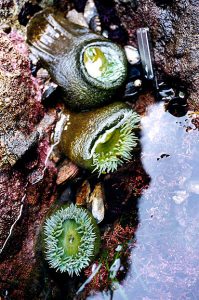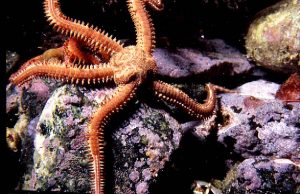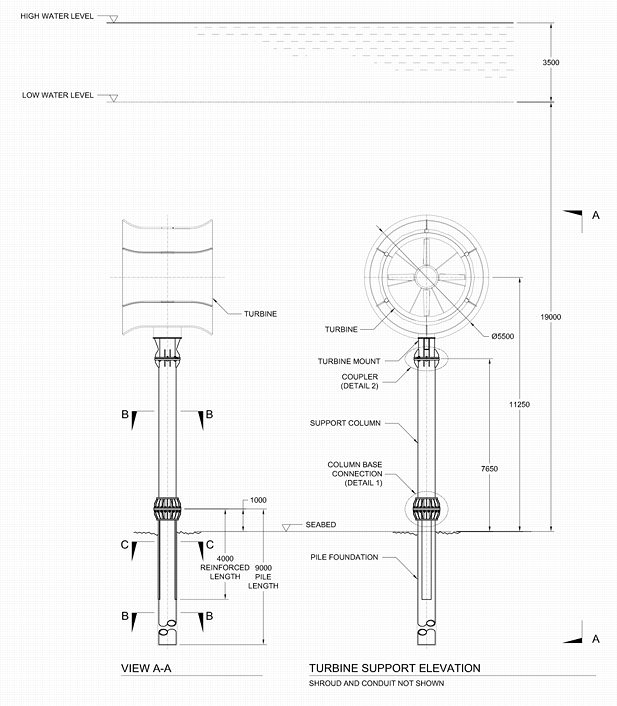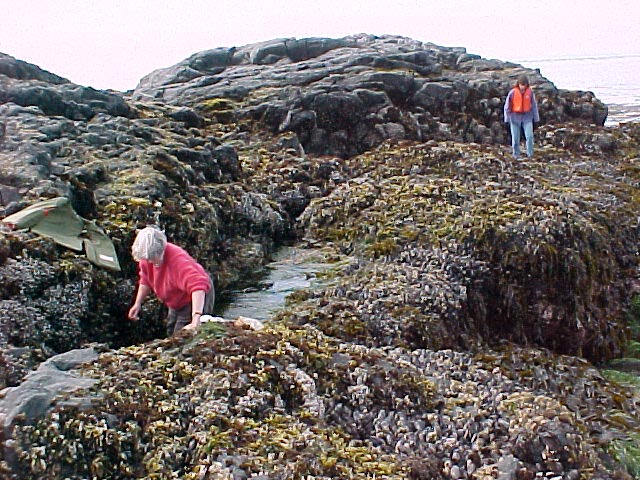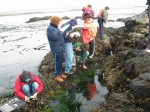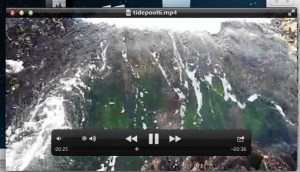File No: 85700-35/0210206
BC Parks Impact Assessment Process
Level 1, Preliminary Screen Report
Name of Action: Installation of Electrical Cable Channel and Conduits at Race Rocks.
Proponent: Lester B Pearson College and Clean Current Power
Review Date(s): May 17, 2005 Page: 1of 3
- Issues and Environmental Components
- List any issues of concern that have been or may be raised by BC Parks, other government agencies, First Nations, or the public.
- No habitat loss should take place.
- Impacts that could potentially be damaging to other wildlife and plant communities as a result of demolition/construction activities.
- Identify any geographic “hots pots” at or close to the proposed action (e.g., areas of high use, concentrations of facilities, wilderness conservation zones, unique landscape features).
The proposed location of the cable entry to the water from the island is represented below.

This would allow construction in the intertidal area during mid-May to mid-June in a location where there is already extensive human-created infrastructure, and where there is no impact to nesting birds. It also enables us to provide needed repair of the dock structure.
- Identify any important environmental, recreational, social or economic values in the area of the proposed action and/or the area surrounding the proposed action (e.g., rare or endangered species, hiking experience, midden site). Include a rationale as to why the value is considered important.
There are none of the above values with this route along the docks that could be considered an impediment. Pam Thuringer of Archipelago Marine did a survey of the area at low tide on May 12. She found no rare or significant species in the area that will not recover in a short period afterwards. Link to her species list here
Preliminary Screen Checklist Page: 2 of 3
Complete the following based on information available and/or the experience of BC Parks staff at the time of the review.
- BC Parks has a responsibility to comply with the following Acts and regulations. Indicate that the proposed action complies with the following: Done ( or N/A)
Park Act, Park Amendment Acts Yes
Ecological Reserve Act Yes
An order issued under the Environmental Land Use Act n/a
BC Environmental Assessment Act n/a
Waste Management Act n/aHeritage Conservation Act (i.e., Archaeological Impact Assessment Guidelines) n/a
Federal Fisheries Act (Department of Fisheries and Oceans) n/a
Other (specify):
Comments:
BC Parks should ensure that all actions comply with BC Parks policies. Indicate that the proposed action complies with the following: Done
Approved management plan or management direction statement (MDS)Yes
BC Protected Areas Strategy: Resource and Recreation Use Guidelines for Protected AreasYes BC Parks Policy including conservation and recreation goals (Striking the Balance) Yes
BC Parks Policies (specify):Eco reserves set aside for protection and research Yes
BC Parks ConservationProgramPolicies yes
BCParksAnnualManagementPlan (i.e.,values and targets)n/a
Other (specify):
Comments:
Page:3 of 3 3.
Document which agencies /stakeholders that have been or should be notified and/or contacted: yes” Done ( or N/A)
Conservation Data Centre n/a Ministry of SRM (specify branch):
Ministry of Forests (i.e., Range Act) n/a
Ministry of Energy and Mines (Mineral Tenure Act) n/a
Ministry of Health Services n/a>
First Nations Yes
Agencies responsible for broader level plans (i.e., Regional District, LRMP) n/a
Other (specify):
Comments (include name and title of contact):
The proposed action is likely to result in the following impacts (check all that apply) Done
(U or N/A)
Adverse and permanent effects on the important conservation, recreation and/or cultural heritage values n/a
Adverse and permanent effects on the character and aesthetics of the protected area n/a
Adverse effects to endangered, threatened or vulnerable or regionally significant species, populations and habitats (i.e., red/blue-listed species/habitats, biogeoclimatic representation) U
Adverse effects to critical or geographically unique characteristics U
Adverse effects to public health and safety n/a
Adverse effects to traditional use of the area by First Nations n/a
Adverse effects to local communities n/a
Adverse effects to the recreational use or enjoyment of the park (regardless of the intended benefits of the proposed action) n/a
Economic implications, such as operating costs, that cannot be maintained over time n/a
A high level of controversy or public concern regarding the action n/a
Effects of the action, which when combined with the effects of other actions in the region, may result in cumulative impacts n/a
Implications which may be precedent-setting and should therefore be considered in the context of similar future actions n/a
Comments (use corresponding letters to refer to specific impacts listed above):
- Level 1 report should recommend appropriate times and methods for construction to ensure birds/wildlife impacts are kept to a minimum.
to ensure birds/wildlife impacts are kept to a minimum.The site where the cable would enter the sea, is on the west side of the Jetty. This area can receive concrete cladding of a reinforced conduit right down to the end of the jetty, if concrete is poured at one of the upcoming low tides in the next month, in order to avoid pouring underwater.
The proposal involves a protective conduit that can be bolted to the wall of the jetty. This same conduit would enter the water and carry the cable down to the depths, where intertidal damage from rolling rocks would not occur.
A further advantage of this proposal is that we would require that the west wall of the jetty would re-enforced with concrete in order to repair some of the undermining of the jetty. In some areas this has gone in as far as 60 to 80 centimeters. That part of this erosion of the jetty could be the result of it not being fully filled in with new concrete when the jetty was partly rebuilt in 1986. It looks very much like the older exposed loose concrete and fill was the part that has eroded. The dock was constructed sometime pre-1950 on a rock finger projecting seaward.
By using camera 5 remote control at you can see this area easily if you choose the pre-selection of “Jetty”. By zooming in at low tide, the base of the dock can be seen almost to the end.Construction Method: Roma Construction is being contracted for the above water portion of the job.This job consists of two parts:
Part a) Consists of immediate work, to commence within the next week, in order to take advantage of the upcoming sets of low tides during the daytime. A 6 inch solid conduit in 25’ sections (HDPE ) will be embedded in concrete for the length of the docks shown here in magenta. Removal of the surface coating of algae and sessile invertebrates will be done only in the area of the new concrete addition. Any large motile invertebrates will be displaced manually from the immediate area prior to the cleaning. No chemicals will be used in the cleaning process as a directed water jet should be adequate. The dock will be repaired along this side in the process, with holes and unstable portions filled in. Also included in this operation will be the inclusion of a 4 inch conduit for telemetry and cables as well as a 1.25 inch poly hose for water intake.
Concrete will be made on site from materials transported to the island. Any debris created during the process will be hauled off the island for disposal.
Chris Blondeau, operations manager and Garry Fletcher, Ecological Reserve Warden, will be on site to oversee the environmental concerns. In addition, Pam Thuringer and staff of Archipelago Marine have been contracted to do an ongoing environmental assessment for the duration of the construction phase of the project during the next year.

 The whale barnacle living as a commensal on Gray Whales
The whale barnacle living as a commensal on Gray Whales





